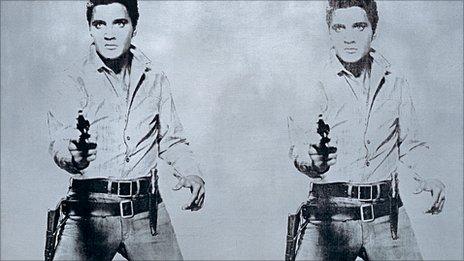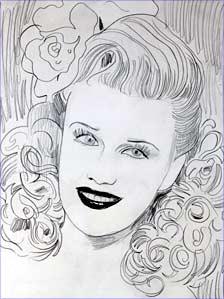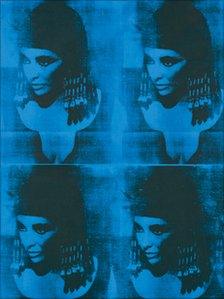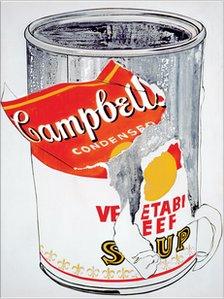Warhol's pivotal years
- Published

Warhol created a number of works based on the image of Elvis
A major new exhibition of works by Andy Warhol focuses on a four-year period pivotal to his development as an artist.
"This is a very focused exhibition, concentrating on the years from 1961 to 1964," explains Bernhard Burgi, director of Basle's Kunstmuseum.
"This period is fantastic - I think it is the heart of everything Andy Warhol did."
The key to the exhibition is the way it traces the pop artist's transition from a more traditional artistic approach to using subjects repeatedly, in the same canvas, and moving to a more mechanised production of his work.
Repetitive style
Warhol is especially famous for his Campbell's soup cans. After apparently being advised by a friend to paint subjects that he liked, he chose Campbell's soup because, he said, he ate it almost every day.
In Basle, an individual version is on display, together with early sketches of soup cans.

They are followed in the exhibition by Campbell's 100 Soup Cans in which Warhol used spray paint to achieve the repetitive style which became one of his hallmarks.
"Warhol's work is about repetition," explains Mr Burgi.
"So in this exhibition we wanted to make very clear statements so the visitor can realise how he advanced and how he treated certain subjects."
In order to achieve this focus, the museum decided not to include any of Warhol's comics, which he was also producing at the time.
But several rare sketches have been included, among them pencil and pastel piece Cosmetics and a pencil sketch of the actress Ginger Rogers.
Basle has the biggest collection of Warhol drawings and prints on paper outside the Andy Warhol Museum in Pittsburgh, Pennsylvania.
"He was a very talented draughtsman," says Mr Burgi.
"He had to do a lot of it as a graphic designer in the 1950s. And these drawings are autonomous, not sketches for later paintings.
"He was drawing these and working on Campbell's soup at the same time."
Darker subjects
But perhaps the highlights of the Basle show are the screen prints of two of the mid-20th Century's biggest stars - Elizabeth Taylor and Elvis Presley.

Warhol creates "rhythms and moments of composition"
Here, too, the famous repetition is clear in a double Elvis from 1963 as well as Elvis 4 Times, a silk screen in ink and silver paint.
It is in this section of the exhibition that Blue Liz - Mr Burgi's personal favourite - appears.
"It's Liz Taylor, a still from her in her role as Cleopatra which was an incredibly famous film at the time," he explains.
"He had started to work with the silk screen technique and here we can see he is playing with the repetition of the same image, on this very beautiful blue background."
In the silk screen, Warhol provides variations of length and shade within the different rows.
"So he is really playing with this mechanical addition of the motive and he creates certain rhythms and moments of composition, as in a traditional painting," adds Mr Burgi.
Warhol chose some darker subjects for this repetitive style as well.
The Basle exhibition has one room devoted to pieces from his Death and Disaster series which use newspaper clippings of fatal car crashes as their source material.
$100m sale
By 1964, Warhol's artistic output was enormous - he had renamed his studio The Factory and he employed a number of assistants.
Mr Burgi says Warhol's subject matter, including photographs, soup cans and soap boxes, and use of repetition - not just in the same painting but over a series of works - made him prone to forgery.

Warhol's Campbell's soup cans are as ubiquitous as the original product
"And naturally, because Warhol was an extremely successful artist, I suppose you could be tempted to make a fake Warhol and make a lot of money," he adds.
A series of apparently genuine Warhol Brillo soap pad boxes, which sold not long ago for large sums of money, are now believed by many Warhol experts to be forgeries.
The trade in genuine Warhols, meanwhile, has become a multi-million dollar industry.
One of the Elvis series of paintings sold recently for $100m (£64.7m), a price that only four other artists - Pablo Picasso, Jackson Pollock, Gustav Klimt and Willem de Kooning - have achieved.
And Basle's museum shop is doing brisk Warhol business with T-shirts and Liz Taylor magnets among items for sale.
Not to mention, of course, merchandise emblazoned with the Campbell's soup cans which have become at least as ubiquitous as the original product.
Warhol's soup cans have helped to guarantee an enduring fame for the artist who predicted 15 minutes in the spotlight for all.
- Published1 July 2010
- Published23 June 2010